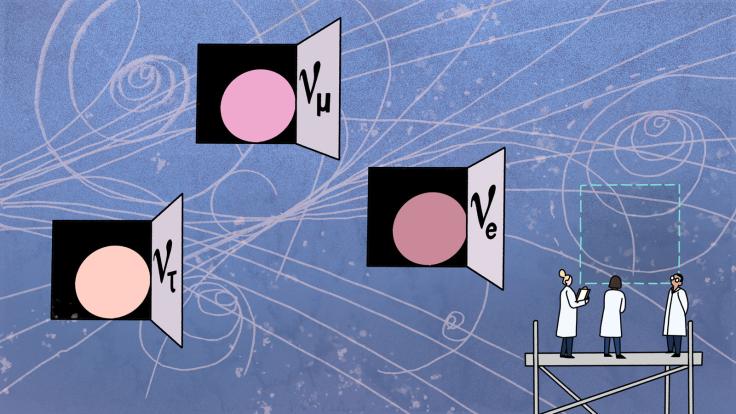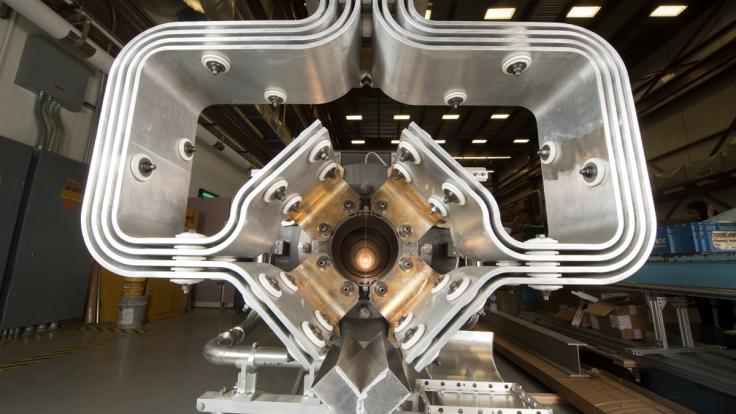As children, many of us played at the possibility of digging a hole so deep it could reach the center of the Earth, or even clean through to the other side of the planet. For neutrinos—subatomic particles that easily pass through most matter—actually taking such a journey is child’s play.
“Geoneutrinos,” neutrinos that stream naturally from the Earth’s interior, are giving scientists the best direct evidence of what’s at work in the belly of the planet. Released by naturally occurring radioactive isotopes inside the Earth, geoneutrinos carry information about what makes the Earth’s insides hot; what elements make up the core of our planet and in what concentration and distribution; how the Earth’s mantle and tectonic plates move and interact; and how planets like our own form and evolve.
Geoneutrinos’ usefulness as tracers for the inner Earth’s chemistry, heat energy and associated physics were first proposed in the 1960s, yet it was only in 2005 that anyone actually observed these ghostly particles.
Giorgio Gratta, a Stanford University physicist, says geoneutrino research has quickly made a mark in geology and geophysics.
“This is the first applied neutrino physics. It’s quite remarkable that neutrinos already have an application, and the time [it's taken] to find this application has actually been quite short,” he says.
A better view of the inner Earth
The Earth’s outer crust hides several layers, reaching down through the solid mantle to its liquid outer core and solid inner core. Researchers have traditionally found out about these layers by studying seismic waves, electromagnetic and gravity fields, meteorites, the contents of volcanic flows, and geothermal heat escaping from boreholes. They also conduct laboratory experiments simulating pressures and temperatures thought to exist in the planet’s mantle and core.
Using these methods, geochemists have built models to describe the concentration of heat-producing elements in the inner Earth, including radioactive uranium, thorium and potassium. They estimate that about 44 trillion to 46 trillion watts of total heat energy is released from the Earth's interior, with at least half coming from radioactive decay. The leftover heat from the planet's formation, given off by the Earth’s cooling mantle and core, are thought to be responsible for the bulk of the remaining heat energy.
Yet deducing everything that takes place deep within the Earth—a place scientists cannot explore first-hand—is extremely difficult, and there are still many unknowns.
That’s where geoneutrinos fit in, offering the most direct observations of the planet’s interior to date. By studying particles that emerge from radioactive decay within the planet, scientists get a new perspective on what’s going on down there.
Geoneutrino measurements are already helping to set constraints on how much radioactive decay contributes to the planet’s total heat budget. Geoneutrinos also can provide a fuller picture of the way Earth’s inner layers interact in processes known as subduction, when one plate slides under another, and convection, when magma pushes up through the crust and forms new crust. Ongoing research is expected to further improve models of how our planet formed and how it is changing.
“At present, geoneutrino detection is the best way to give us the information we need” about the heating activity within the Earth, says Wim van Westrenen, a professor in planetary evolution at VU University Amsterdam in the Netherlands.
The quest for geoneutrinos
While geoneutrinos can yield important data about the inner Earth, they are challenging experimental subjects.
An inherent problem is the difficulty in measuring the tiny, elusive particles. Scientists at the KamLAND experiment in Japan, the first experiment to observe geoneutrinos, reported a grand total of 116 likely geoneutrinos in its first decade of operation, through 2012. The Borexino collaboration, the second experiment to see them, reported observing just 14 particles strongly resembling geoneutrinos over almost four years of operation. That’s not very many.
Researchers are only seeing part of the picture. While their detectors—which were designed to study anti-neutrinos generated in nearby nuclear reactors, not geoneutrinos—are sensitive enough to record the higher-energy geoneutrinos produced in the inner Earth by the radioactive isotopes thorium and uranium, they completely miss a broad swath of the lower-energy geoneutrinos produced by other elements like potassium.
Widening the net
To learn all we can about the interior of the Earth from geoneutrinos, scientists need to catch significantly more of them. To do that, they need bigger, better detectors in more ideal locations.
“You need to collect more data,” Gratta says. “If KamLAND were 10 times larger, and the same thing for Borexino, it would be a huge improvement. At that point you could tear apart different geological models. Much larger statistics will definitely help.”
A new experiment expected to begin operation later this year in Ontario, Canada, SNO+ (pronounced “snow-plus”), will take a step in that direction. Its predecessor, SNO, recorded neutrinos as they sped through a 1000-ton tank of heavy water.
SNO+ will allow the detection of geoneutrinos with lower energies than its predecessor, on par with the sensitivity of KamLAND, by replacing the water with linear alkyl benzene, a liquid that allows for more sensitive measurements. Because of its location, in the middle of a continental plate rich in uranium and thorium, researchers expect SNO+ will detect about one-third more geoneutrinos each year than KamLAND, which detects a mix of neutrinos from the continental and oceanic crusts. SNO+ is also expected to pick up 75 percent fewer signals from man-made, reactor-produced anti-neutrinos than KamLAND. Future upgrades may further enhance the sensitivity of SNO+ detectors to measure lower-energy particles.
The thin-crust option
In the long term, however, the ideal geoneutrino experiment would take place in a more exotic location. “You’d like to go to a place where the crust is thin,” Gratta says.
Placing detectors in thin spots gives scientists a better chance of detecting geoneutrinos coming from below the crust, in the mantle—the region researchers know very little about.
A whopping 75 to 80 percent of the geoneutrinos detected to date were produced in the crust, says Jelena Maricic, assistant professor of physics at University of Hawaii. So there’s a lot still to learn about what’s happening below.
A proposed experiment called Hanohano would take a detector to the place where Earth’s crust is thinnest: below the ocean. There, an experiment seeking to study geoneutrinos from the Earth’s mantle would have a second advantage. Four kilometers of water would shield the experiment from other particles—the noise of which can blur the neutrino signals.
“The bottom line is that we need data from all of these experiments since they sample different parts of the Earth’s crust,” Maricic says. “Like pieces of the puzzle, only together can they give us a more refined, sharper image of the uranium and thorium distribution inside our planet, and finer details of the heat flow and plate tectonics.”
The potential payoff of geoneutrino research spans fields from the Earth sciences to cosmology to particle physics—not to mention geology, Maricic says.
The geoneutrino ‘Renaissance’
Stanford geophysicist Norm Sleep uses a simple analogy to describe the challenge ahead in geoneutrino research. If you are digging for gold and there is only one nugget of gold in each ton you dig, you have to sample a lot of the rock to figure that out, he says. Otherwise, you may get lucky in the first shovelful and think that a pile of mostly gravel is actually full of riches.
Likewise, geoneutrino research requires a broad set of data to tell us the real concentration and distribution of radioactive isotopes in the Earth’s crust and mantle.
Sleep also hopes that geoneutrinos will eventually be able to serve as an early warning system. While the data won’t likely tell us when the next earthquake will hit, it might help identify where: in places where the continents are weak or have a slightly higher heat flow.
“The heat in the Earth acts slowly,” Sleep says. “It takes a long time for radioactivity to heat anything up, so it’s not going to likely tell us whether there’s going to be an earthquake on Tuesday or Thursday. But it’s going to possibly give us a little better understanding of where continents are weak.
“It’s basically revolutionary for earth science.”
Maricic agrees: When geologists realized the potential use of geoneutrinos research, “it was basically a Renaissance,” she says. “Neutrino geophysics: that’s a name that just didn’t exist seven or eight years ago. It took time to make geologists realize it, but when they did, they were very excited.”














